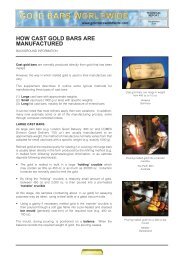Indian Gold Book:Indian Gold Book - Gold Bars Worldwide
Indian Gold Book:Indian Gold Book - Gold Bars Worldwide
Indian Gold Book:Indian Gold Book - Gold Bars Worldwide
You also want an ePaper? Increase the reach of your titles
YUMPU automatically turns print PDFs into web optimized ePapers that Google loves.
JEWELLERY WHOLESALERS<br />
Jewellery wholesalers, acting as middlemen between fabricators and retailers, normally expect to make a gross profit of<br />
2 - 3%. It can be higher if credit is given.<br />
They are normally paid in cash, or in the form of gold. As many major wholesalers also produce jewellery on a speculative<br />
basis (not just in response to orders), their profitability can depend on movements in the standard bullion price.<br />
JEWELLERY RETAILERS<br />
Methods of payment<br />
Retail customers obtain new gold jewellery using one or a combination of 4 methods. In summary:<br />
• Cash payment. Some retailers now also accept credit cards.<br />
• Exchange of old for new jewellery. Its value is credited.<br />
• Supply of bars and coins. The gold content value is credited.<br />
• Supply of old jewellery for refashioning into new jewellery.<br />
Retailers normally communicate a breakdown of pricing elements, although some can be combined and the terminology can<br />
vary. In summary:<br />
Carat gold price<br />
Quoted in rupees per gramme at the appropriate caratage.<br />
Labour charge<br />
Normally quoted in rupees per gramme, although a flat amount can also be quoted.<br />
Wastage charge<br />
Normally quoted as a percentage.<br />
Hallmarking charge<br />
If applicable, a supplementary charge is sometimes levied.<br />
PRICING AND PROFITABILITY<br />
State sales and other taxes<br />
Variable by State and city.<br />
Carat gold price<br />
Carat gold prices per gramme or per 10 g are normally displayed in most outlets. For example, at K22 and K18, and<br />
sometimes K24, K23 and K21 as well.<br />
The price usually reflects that calculated by the local jewellery association. It is based on the prevailing local standard<br />
bullion price per gramme or TT.<br />
The carat gold price is not always directly proportional to the standard bullion price, as it sometimes includes a surcharge<br />
that may also include part or all applicable State and municipal taxes on jewellery, and a contribution to wastage.<br />
For example, if the standard bullion price is Rs 450 per gramme, the quoted K22 price may be Rs 430 (as opposed to a<br />
proportional carat price of Rs 412).<br />
The carat gold price is used as the basis for buying, selling and exchanging jewellery.<br />
Labour charges<br />
“Labour” or “making” charges are normally expressed in rupees per gramme, although for small low weight items (such as<br />
rings, earrings and nose pins), the labour charge can be a fixed amount per item.<br />
In small suburban and rural outlets (usually where the retailer fabricates the jewellery on-site), the labour charge is often a<br />
fixed amount per item. Although the charge can vary according to the weight of the item, the cost is not necessarily<br />
calculated on a consistent rupees per gramme basis.<br />
The tables below can only provide a rough indication of the approximate level of labour charges quoted for different<br />
jewellery categories. The charges, especially at the top end, are inevitably dependent on the intricacy of designs and the<br />
quality of craftsmanship, and whether the wastage cost is included.<br />
AN INTRODUCTION TO THE INDIAN GOLD MARKET 157

















